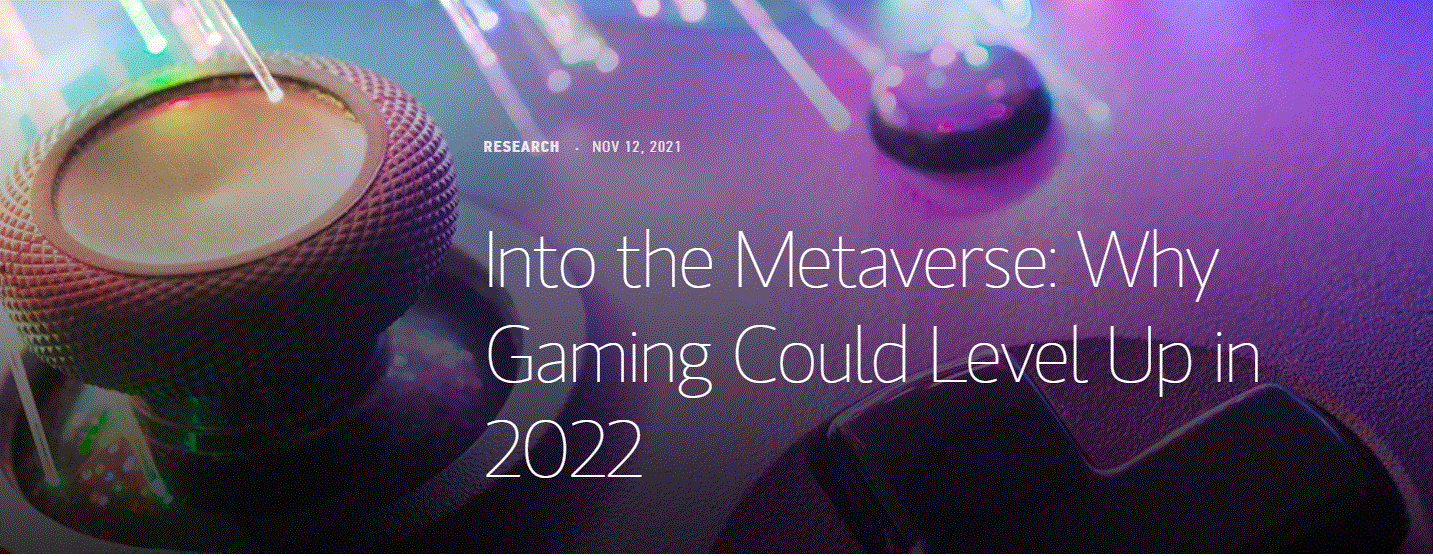Pandemien har skabt et stærkt voksende marked for gaming. I 2020 tog 50 millioner amerikanere fat på gaming-platforme – en stigning på 31 pct. Gaming er blevet et stort marked, da spillerne ikke blot køber konsoller, men det “spillerudstyr”, de bruger i spillet for at udtrykke deres roller og personlighed. De køber udstyr, som de køber tøj, biler og smykker for at skabe prestige og identitet i den virkelige verden. Det sker med konstante mikro-transaktioner. Der er tre grunde til, at gaming er blevet en industri og et hot investor-emne, vurderer Morgan Stanley: 1. Gaming er blevet populært i alle aldersgrupper – halvdelen af alle amerikanere deltager i gaming. 2. Gaming udvisker forskellen på underholdning og social kontakt, fordi 30 pct. betragter gaming som en social aktivitet, fordi spillerne får kontakt med andre, og de kan få kontakt med spillere i hele verden. 3. Den sociale kontakt i gaming er særligt vigtig for unge, hvor 25 pct. betragter gaming som en vej til mere social kontakt.
Into the Metaverse: Why Gaming Could Level Up in 2020

Learn why new gaming platforms, in-game monetization and the merging of social media and gaming could fuel further growth in the gaming industry. A look at three trends for investors to watch.
Gaming has quietly been a key industry in the entertainment sector for years, but like many digital experiences, the pandemic helped fuel outsized growth. In 2020, 50 million Americans took up gaming according to Morgan Stanley Research, a 31% year-over-year increase. Compare that to the previous two years, when users grew by just 7%.
“While a certain amount of regression is expected as pandemic reopening accelerates and people spend less time in virtual realities, many secular trends in the gaming industry are likely to remain in place,” says Equity Analyst Brian Nowak who covers the Internet industry.
- The number of gamers and time spent on gaming is increasing.
- Players can play with, compete against, and connect with gamers from all over the world, creating a global consumer market.
- The popularity of microtransactions and other forms of in-game monetization offer more ways to benefit from increasing usage.
For investors, three key developments may be worth watching:
Social-gaming convergence
Despite the antisocial stereotype that’s often ascribed to gaming enthusiasts, gaming has increasingly become a means for making, building, and maintaining social relationships.
Recent findings from AlphaWise—the proprietary survey and data arm of Morgan Stanley Research—found:
- Gaming is popular across all ages and demographics. In fact, half of all surveyed U.S. residents engaged in some form of video game play since the start of the pandemic, whether on a PC, gaming console, or mobile device.
- The lines between entertainment and socialization are blurring. While the primary motivation for most gamers is entertainment, nearly a third (30%) of surveyed gamers say games are first and foremost a means to social connection.
- The social aspect of gaming is especially important for younger gamers. More than a quarter of respondents under the age of 35 say gaming provides a better avenue for social connection than social media itself.
“These trends indicate a merging of social media and gaming, which could help accelerate the growing popularity of platforms that provide fully-fledged digital environments using virtual and augmented reality devices,” says Nowak.
In-game monetization
The social aspect of gaming feeds into an important source of revenue for the industry: microtransactions.
In the same way that people buy clothing, cars, and jewelry to confer status in the real world, gamers conduct in-game purchases to express their personalities and connect with others in the virtual world.
On mobile games, in-game transactions buy power-ups, new lives, or ad-free subscriptions to a game. For console gaming, gamers can purchase weapons to improve their play and fancy cars to flaunt to fellow gamers. This practice is taken to its extreme in metaverse gaming, in which users will speculate on real estate within a digital world.
Bottom line: These transactions foster user engagement and can help drive long-term revenue growth.
New games on new platforms
Several new gaming consoles have been released this year, presenting an opportunity for game makers to develop ground-breaking new titles. These new consoles, with new processor architecture, higher visual resolution and faster storage, also allow game studios to re-release classic titles, only this time with enhanced gameplay.
Additionally, there’s opportunity to reimagine console games for mobile devices. Many of today’s popular mobile games are, in fact, mobile versions of console games.
The marketing of these consoles and their accompanying games, both old and new, may continue to drive user spending in the coming years.
Of course, no industry is immune to risks—especially one that benefitted immensely from the unique stay-at-home environment from the pandemic. “But given the rising social aspect of gaming, combined with video-game publishers’ ability to monetize increased engagement, we see significant upside for the industry on a go-forward basis,” says Nowak.

